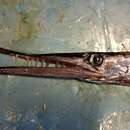Diagnostic Description
provided by Fishbase
In adults, head depth 23.2-26.8% of lower jaw length. Postorbital area 5.5-7.6% SL or 28.8-33.3% (less than 3 times smaller than HL). Rear edge of gill cover overlaps with the middle of the 4th vertebrae. Postadipose distance 6-7.4% SL (Ref. 31260).
- Recorder
- Estelita Emily Capuli
Morphology
provided by Fishbase
Analsoft rays: 12 - 15; Vertebrae: 77 - 81
- Recorder
- Estelita Emily Capuli
Trophic Strategy
provided by Fishbase
Inhabits the epimesopelagical layer. Juveniles and fry observed exclusively within the central-circle current and its periphery; large adults caught mainly in boreal and subarctic waters. Feeds mainly on small and moderate-sized mesopelagic fishes; the largest Paralepis coregonoides and Arctozenus risso, had body length of 28-30 cm; a specimen caught from the southern region of Reykjanes Ridge had 12 individuals of Sebastes mentella ranging from 4.5-5 cm. Stomachs of those caught in the Mid-Atlantic Ridge have small squids (Ref. 31260). Preyed upon by cod, halibut, whales and albacore (Ref. 5951).
- Recorder
- Grace Tolentino Pablico
Biology
provided by Fishbase
Epimesopelagic species. Juveniles and fry observed exclusively within the central-circle current and its periphery; large adults caught mainly in boreal and sub-arctic waters. Feeds mainly on small and moderate-sized mesopelagic fishes; the largest Paralepis coregonoides and Arctozenus risso, had body length of 28-30 cm; a specimen caught from the southern region of Reykjanes Ridge had 12 individuals of Sebastes mentella ranging from 4.5-5 cm. Stomachs of those caught in the Mid-Atlantic Ridge have small squids (Ref. 31260).
Anotopterus pharao
provided by wikipedia EN
The daggertooth (Anotopterus pharao, meaning "without fins on its back, of the Pharaoh") is a species of daggertooth. Its distribution includes the North Atlantic Ocean and west of Africa. The record size for this species is 96 cm and was hermaphroditic. Daggertooths are occasionally found dead in bottom trawls used for firefly squid or shrimp. They are similar to needlefish or gars. However, they are distinct. Netted daggertooth specimens are rarely identifiable, mostly because of their soft bodies, which are easily torn or flattened. This is typical of benthic animals of the deep ocean, like some transparent squids. In fact, the bodies are so soft, when pushed against the back of a trawl net, they often die because their organs are crushed and they rip. The habitat of the daggertooth is the open abyss, where few obstacles occur with which to come into physical contact.
References

- license
- cc-by-sa-3.0
- copyright
- Wikipedia authors and editors
Anotopterus pharao: Brief Summary
provided by wikipedia EN
The daggertooth (Anotopterus pharao, meaning "without fins on its back, of the Pharaoh") is a species of daggertooth. Its distribution includes the North Atlantic Ocean and west of Africa. The record size for this species is 96 cm and was hermaphroditic. Daggertooths are occasionally found dead in bottom trawls used for firefly squid or shrimp. They are similar to needlefish or gars. However, they are distinct. Netted daggertooth specimens are rarely identifiable, mostly because of their soft bodies, which are easily torn or flattened. This is typical of benthic animals of the deep ocean, like some transparent squids. In fact, the bodies are so soft, when pushed against the back of a trawl net, they often die because their organs are crushed and they rip. The habitat of the daggertooth is the open abyss, where few obstacles occur with which to come into physical contact.
- license
- cc-by-sa-3.0
- copyright
- Wikipedia authors and editors
Diet
provided by World Register of Marine Species
Molluscs, crustaceans, marine worms, coelenterates, salps and fishes
North-West Atlantic Ocean species (NWARMS)
- license
- cc-by-4.0
- copyright
- WoRMS Editorial Board
Habitat
provided by World Register of Marine Species
Found in a wide range of depths, sometimes near surface to below 2,000 m. Larger adults inhabit colder water toward the poles, whereas, the young and smaller adults inhabit more temperate regions.
North-West Atlantic Ocean species (NWARMS)
- license
- cc-by-4.0
- copyright
- WoRMS Editorial Board
Habitat
provided by World Register of Marine Species
nektonic
North-West Atlantic Ocean species (NWARMS)
- license
- cc-by-4.0
- copyright
- WoRMS Editorial Board

